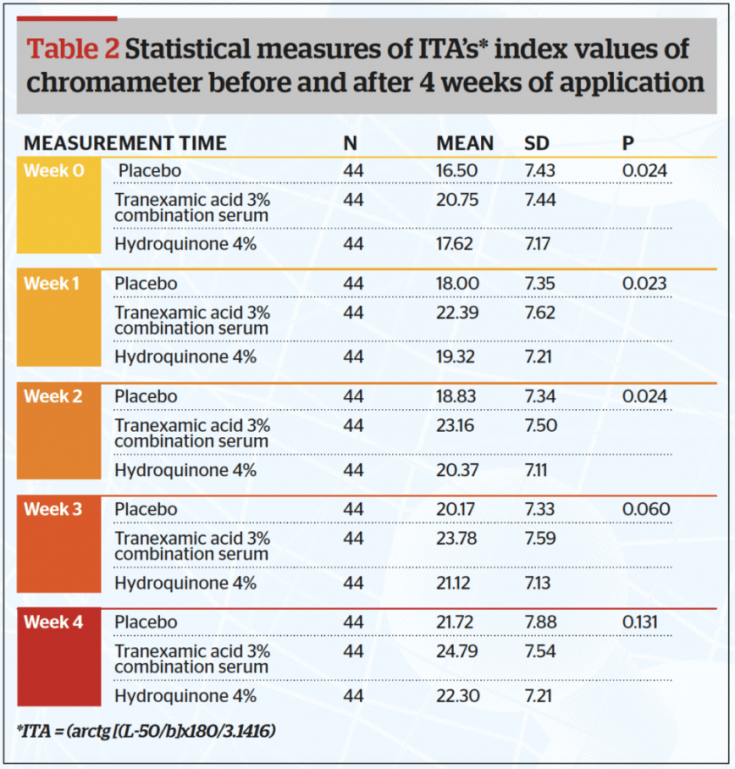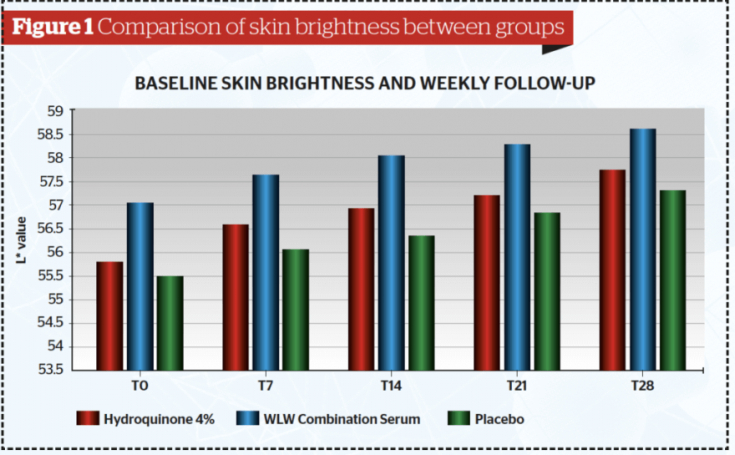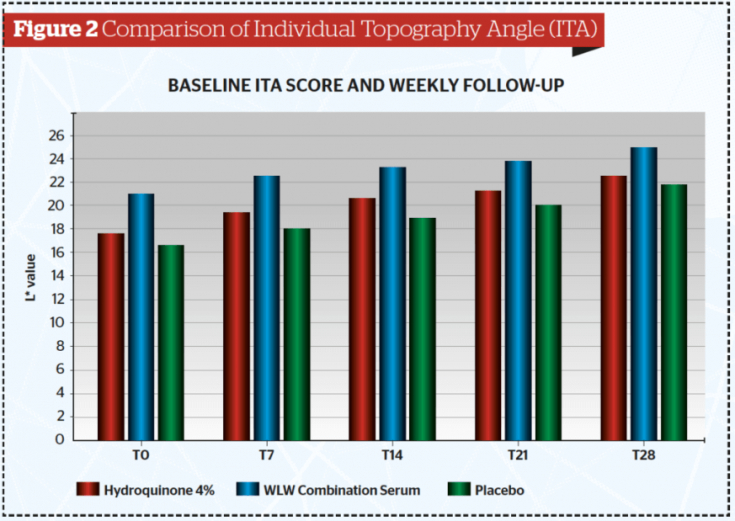Disturbance of skin pigmentation can negatively affect the appearance and psychological state of patients.
The low safety profile of hydroquinone, the gold standard for skin whitening, is pushing clinicians to look for other effective hyperpigmentation therapeutic agents. One of them is tranexamic acid.
The results of a double-blind, randomized, placebo-controlled clinical trial comparing the efficacy of tranexamic acid and hydroquinone for skin whitening are presented in this estet-portal.com article.
Study authors – Anis Irawan Anwar, Siswanto Abdul Wahab, Widya Widita, Airin R. Nurdin, Suci Budhiani, Arifin Seweng.
- Tranexamic acid vs. hydroquinone: study background
- Skin-Bleaching Substances Research: Patients and Methods
- Study Findings: Can Tranexamic Acid Be an Alternative to Hydroquinoney
Tranexamic acid vs. hydroquinone: study background
The use of a single tyrosinase inhibitor has been replaced by the use of combinations of active substances with different target mechanisms.
So:
- Galactomysis Enzyme Filtrate (GFF) reduces the severity of skin pigmentation by reducing melanin synthesis and oxidative stress in melanocytes.
- Niacinamide, in addition to inhibiting tyrosinase activity, also plays a role in blocking the movement of melanosomes into keratinocytes.
- Arbutin – a natural derivative of hydroquinone of plant origin, which in non-toxic concentrations is able to inhibit melanosome tyrosinase.
This study aims to comparison of the efficacy of tranexamic acid 3% and other brightening ingredients (galactomysis 2%, niacinamide 4% and alpha-arbutin 2%) with hydroquinone and placebo preparationso .
Whitening cannot be left: whether to use cosmetics with hydroquinone against pigmentation
Research on Skin Whitening Substances: Patients and Methods
This double-blind, randomized, placebo-controlled clinical trial was conducted at the Department of Dermatovenereology, Hasanuddin University (Makassar, Indonesia).
44 women aged 25-50 years took part in a 4-week study.
Inclusion Criteria:
- Fitzpatrick phototypes III–V;
- willingness to participate in the study;
- signed informed consent form.
Exclusion Criteria:
- pregnancy/lactation;
- presence of other dermatoses on the hands;
- hypersensitivity to the substances of the drugs used;
- use of other depigmenting agents or procedures on the face within a month prior to the study;
- use of tranexamic acid within 3 months prior to study.
 |
Measurement time – measurement time; Week – week; – placebo; Tranexamicacid 3% combination serum – combination serum with tranexamic acid; Hydroquinone4% – hydroquinone 4%; N– number of participants; MEAN– average value; SD– standard deviation; p– significance level.
|
Table 1. Changes in L (skin lightness) values measured by the colorimeter and
 Measurement Measurement | time – measurement time; Week – week; – placebo; Tranexamicacid 3%combination serum – combination serum with tranexamic acid; Hydroquinone 4% – hydroquinone 4%; N – number of participants; MEAN– average value; SD– standard deviation; p– significance level.
| Table 2.
obtained with colorimeter before and 4 weeks after application of drugs All participants used only products provided in the study for skin whitening. Patients from the experimental group received 3 identical containers with topical serum:
tranexamic acid 3% + galactomysis enzyme filtrate 2% + niacinamide 4% + alpha-arbutin 2%;
hydroquinone 4%;
placebo.- The containers were labeled A, B and C.
- In order to unify the treated areas, each patient was provided with special
- stencils marked A, B and C .
The first two stencils (A and B) are for the outer part of the right forearm, and the third (C) – for the outer part of the left forearm.
The stencil is made of elastic material with two holes – A (for the right forearm) and C (for the left forearm), which are located at a distance of 4 cm from the cubital fossa; hole B is located at a distance of 4 cm from hole A. Apply 1 drop of serum A, B and C to the respective areas of A, B and C each morning and evening.
Tranexamic acid in the treatment of melasma
Skin assessments of patients were performed at baseline and every 7 days for the next 4 weeks.
Skin pigmentationwas assessed using a colorimeter (CR-400, Minolta, Japan) and Individual Topography Angle (ITA). All measurements were taken 4 times with subsequent calculation of the average value. At each appointment, patients were asked to report possible pain, itching, and redness of the skin.
The following parameters were obtained using the colorimeter:
L (skin lightness) – 0 (dark) to 100 (light);
a (skin redness);
b (variation between blue and yellow).- The authors also
- calculated
- ITA – coefficient measuring skin pigmentation (Arctg [(L-50/b]x180/3.141
6). Study results: can tranexamic acid be an alternative to hydroquinone All 44 patients participated in the study until its completion. Data were analyzed and validated by
one-way analysis of variance(ANOVA).
According to
baseline, out of 44 volunteers:
26 subjects (59.1%) under the age of 30;14 participants (31.8%) aged 30-39;
4 patients (9.1%) over 40 years of age.- As shown in
- Table 1 and
- Figure 1 , 4 weeks after application, the mean value of
was highest in patients using the combination serum (58.60), and the lowest – in the placebo group (57.33) (p < 0.05%). Serum containing tranexamic acid was more effective than serum containing hydroquinone. Follow us on Telegram!
The tranexamic acid serum was more effective than the hydroquinone-based serum. As part of the study, the authors calculated the factor
ITAand found that the mean ITA at the end of the study was maximum after application of combined tranexamic acid serum (24.79) and minimum after placebo ( 21.72) (p<0.05).
 L* value L* value | – value L;
Hydroquinone 4% - hydroquinone 4%; – combination serum;
Fig. 1. Comparison of skin lightness in patient groups
|
Baseline ITA score and weekly follow-up – original coefficient. ITA and weekly figures;
 Hydroquinone 4% Hydroquinone 4% | - hydroquinone 4%;
– combination serum;
Fig. 2. Comparison of individual topographic angle (ITA)No adverse events were reported after the use of serums during the study. Correction of hyperpigmentation: the choice of effective treatments for melasma |
with different mechanisms of action can be an alternative to hydroquinone. This study has shown that tranexamic acid 3% in combination with galactomysis enzyme filtrate 2%, niacinamide 4%, and alpha-arbutin 2% can be an effective whitening agent with no side effects.
However, additional, longer-term studies are required to confirm the safety, as well as evaluate the effectiveness of these substances in eliminating other types of hyperpigmentation.
Based on magazine Prime.









Add a comment